The Jason Islands are an archipelago located roughly 160 kilometres off the coast of Argentina in the South Atlantic Ocean.
Known for their breathtaking natural beauty and abundance of wildlife, these islands are a paradise for bird lovers.
The islands are home to a diverse range of bird species, some of which can only be found in this part of the world.
The pristine habitats and favourable climatic conditions make the Jason Islands a great breeding and nesting ground for many bird species.
This article will explore the fascinating world of birds in the Jason Islands and learn more about their behaviour, habitat, and challenges.
14 Jason Islands Birds You Didn’t Know
The Jason Islands, also known as the Sealion Islands, are a group of small islands in the South Atlantic Ocean. They are part of the Falkland Islands and are known for their unique and diverse birdlife.
Here are 14 bird species you might not know to inhabit the Jason Islands:
1. Peregrine Falcon
The Peregrine Falcon is a majestic bird of prey belonging to the family Falconidae. It has a blue-grey back, barred white underparts and a black head, making it easily recognizable.
This intelligent raptor, one of the fastest animals in existence, is known for its incredible speed, reaching over 320 km/h (200 mph) during hunting dives.
The peregrine falcon can be found worldwide, from Arctic tundra to tropical rainforests, thriving with humans or in high alpine mountains far away from civilization.
Their beauty, power and adaptability make them an impressive species that have earned respect among many cultures throughout history as symbols of strength and endurance.
Scientific classification:
| Kingdom | Animalia |
| Phylum | Chordata |
| Class | Aves |
| Order | Falconiformes |
| Family | Falconidae |
| Genus | Falco |
| Species | F. peregrinus |
Also Featured In: Most Common United States Birds, Birds of Sweden
2. Short-Eared Owl
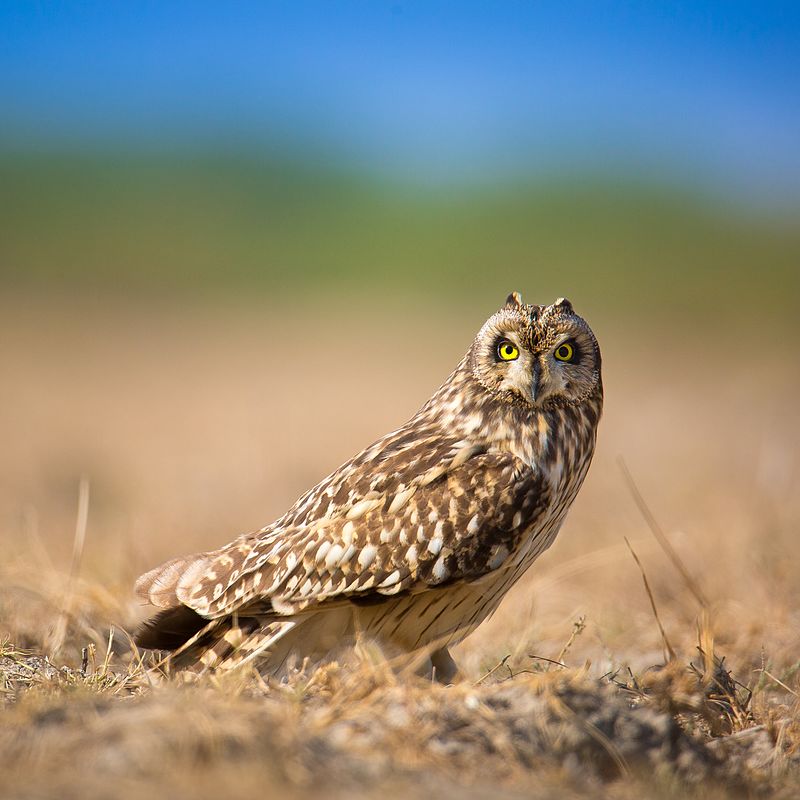
The Short-eared Owl is a species of owl belonging to the genus Asio, commonly known as ‘Eared Owls’. It has short tufts resembling mammalian ears that may or may not be visible.
When threatened, they will display their tufts defensively; however, these short ones are usually hard to spot.
This bird can be found in grassland habitats across much of the world and hunt mainly small mammals, such as voles, at night by swooping low over the ground from perches like trees and posts.
When available, they also take other prey, including birds, amphibians, reptiles and insects.
During the breeding season, males can often be seen performing aerial displays with claps of their wings while hovering above potential mates on territories they defend fiercely against intruders, including humans.
Scientific classification:
| Kingdom | Animalia |
| Phylum | Chordata |
| Class | Aves |
| Order | Strigiformes |
| Family | Strigidae |
| Genus | Asio |
| Species | A. flammeus |
Also Featured In: Egyptian Birds, Galapagos Birds You Should Know
3. Southern Giant Petrel
The Southern giant petrel is a large seabird native to the southern oceans, and it overlaps broadly with its similar counterpart, the Northern giant petrel.
Adults of both species can be distinguished by their bill-tip colour: greenish in the south and yellowish in the north.
The Southern giant petrel also goes by other names such as Antarctic giant petrel, Giant fulmar, Stinker or Stinkpot.
These birds are around 75 cm (30 inches) long on average and have striking white plumage combined with brown wings that give them an impressive appearance while they soar through skies above open waters searching for food like fish, krill and squid – which they can catch up to 100 meters below sea level.
Scientific classification:
| Kingdom | Animalia |
| Phylum | Chordata |
| Class | Aves |
| Order | Procellariiformes |
| Family | Procellariidae |
| Genus | Macronectes |
| Species | M. giganteus |
Also Featured In: Uganda Birds Species, Birds that Live in the Ocean
4. Magellanic Penguin
The Magellanic penguin is a beloved South American bird that breeds in coastal Patagonia, including Argentina, Chile and the Falkland Islands. It migrates to Brazil and Uruguay, occasionally as far north as Espirito Santo.
Vagrants have even been spotted in El Salvador, Antarctica’s Avian Island and Australia/New Zealand.
This penguin species is perhaps most recognizable for its striking black-and-white plumage – it has an entirely white underbelly with two distinctive stripes across its back, black above and white below.
Additionally, they possess large pinkish feet, which act like paddles when swimming underwater; these birds can swim up to 20 mph.
The Magellanic Penguin typically lives around 15 years, but some may live longer due to their strong social bonds within colonies.
This majestic creature makes quite the statement on land or sea – making them a unique addition to our planet’s wildlife population.
Scientific classification:
| Kingdom | Animalia |
| Phylum | Chordata |
| Class | Aves |
| Order | Sphenisciformes |
| Family | Spheniscidae |
| Genus | Spheniscus |
| Species | S. magellanicus |
Also Featured In: Birds of Argentina, Most Common Birds in South America Birds
5. Oystercatchers
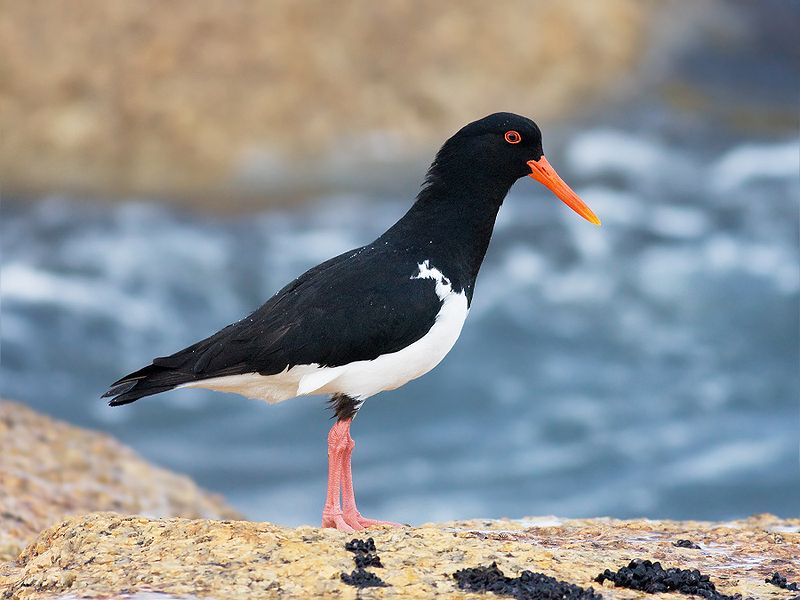
Oystercatchers are a family of waders forming the Haematopodidae, with one genus: Haematopus.
They live in coastal regions worldwide, excluding polar and some tropical areas of Africa & South East Asia.
Eurasian, South Island & Magellanic oystercatcher species also breed far inland – breeding grounds being found much deeper than other family members.
They have long beaks that feed on molluscs such as mussels, clams and oysters, which they crack open using their strong bills.
Oystercatchers are usually quite vocal birds, making various loud calls when disturbed or alarmed.
The males tend to display more brightly coloured plumage than females, who share similar brown/black hues for camouflage purposes during nesting season.
Scientific classification:
| Kingdom | Animalia |
| Phylum | Chordata |
| Class | Aves |
| Order | Charadriiformes |
| Suborder | Charadrii |
| Family | Haematopodidae Bonaparte, 1838 |
| Genus | Haematopus Linnaeus, 1758 |
Also Featured In: Best Birds Watching in Austria, Birds You’ll Find in the Sea
6. Albatrosses
Albatrosses are majestic, large seabirds belonging to the Diomedeidae family in the Procellariiformes order.
These birds have impressive wingspan and can fly far over oceans with minimal effort.
They inhabit all of the world’s southern oceans, ranging from Antarctica to New Zealand and Australia and parts of the northern Pacific Ocean region.
Albatross populations were once abundant throughout much of their range, but they now face threats such as longline fishing gear entanglement, which has caused a significant decline in numbers in some areas.
Furthermore, occasional vagrants have been found outside their native ranges including fossil remains suggesting that albatrosses previously existed on other regions too.
Scientific classification:
| Kingdom | Animalia |
| Phylum | Chordata |
| Class | Aves |
| Order | Procellariiformes |
| Family | Diomedeidae G.R. Gray 1840[1] |
Also Featured In: New Zealand Birds, Most Common Nature Birds
7. Great Shearwater
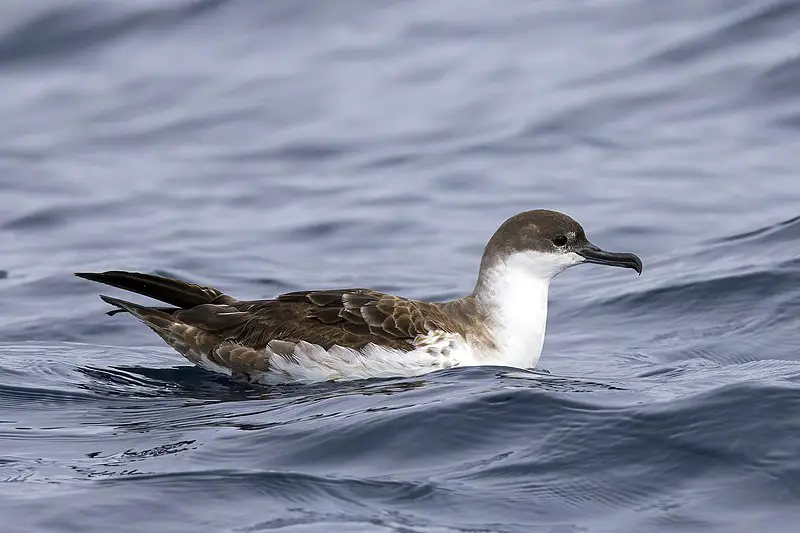
The Great Shearwater is a large seabird from the Procellariidae family. It breeds in colonies on rocky islands located in the South Atlantic, and during non-breeding season, it can be found across most of the Atlantic Ocean.
It was first described by Irish naturalist Bernard O’Reilly in 1818 under its scientific name ‘Procellaria gravis’.
This bird has pale grey upper wings with a white underside that may sometimes show brownish markings around its neck area.
Its diet consists mainly of fish but also small squid, crustaceans and molluscs, which they catch by surface plunging or pursuit diving while flying low over water surfaces.
The great shearwater is threatened to some extent due to human activities like fishing using gill nets, destruction of habitat for development projects, as well as plastic debris ingested through feeding, which affects their health adversely, leading to mortality rates at an alarming rate, making them vulnerable species.
Scientific classification:
| Kingdom | Animalia |
| Phylum | Chordata |
| Class | Aves |
| Order | Procellariiformes |
| Family | Procellariidae |
| Genus | Ardenna |
| Species | A. gravis |
Also Featured In: Cabo Verde birds, Birds that Live in Newfoundland and Labrador
8. Black-Browed Albatross
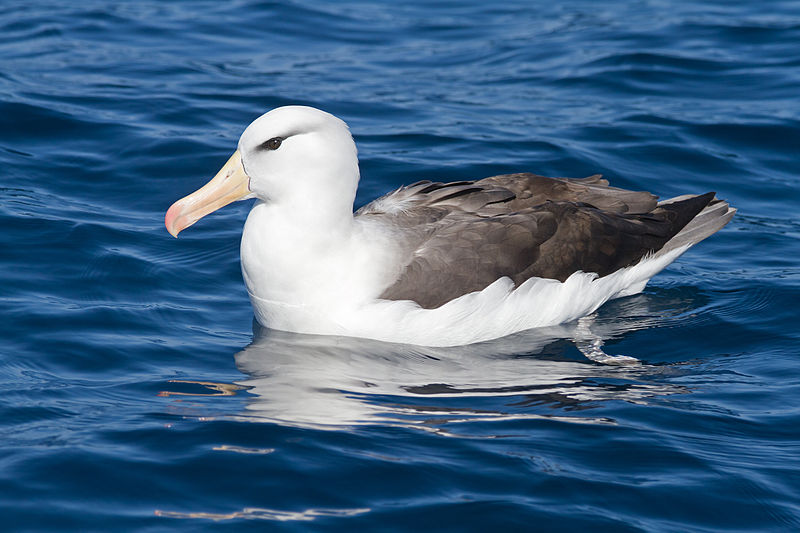
The Black-browed Albatross is a majestic seabird that belongs to the albatross family known as Diomedeidae.
It is an impressive bird, with its black beak and brow contrasting against the white plumage on its wings and body.
The most widespread and common member of this group, it can often be seen flying around oceans in different parts of the world.
These birds share many features with other members of their order Procellariiformes, such as shearwaters, fulmars, storm petrels and diving petrels; they all have long wingspans for gliding effortlessly above water surfaces.
They feed mainly by scavenging or hunting small fish near the sea surface while flying low over the waters.
Its population has unfortunately declined due to commercial fishing vessels, which attract them closer to shore, resulting in entanglement into fishing nets and leading them towards mortality.
Scientific classification:
| Kingdom | Animalia |
| Phylum | Chordata |
| Class | Aves |
| Order | Procellariiformes |
| Family | Diomedeidae |
| Genus | Thalassarche |
| Species | T. melanophris |
Also Featured In: Antarctica Birds, Patagonia Birds You Should Know
9. Gentoo Penguin
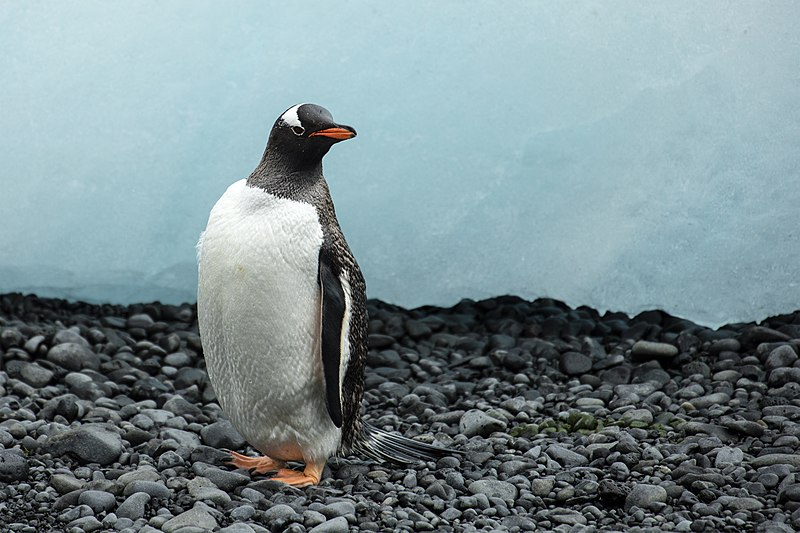
Gentoo penguins are an iconic species of birds found in the Falkland Islands. They have a distinctive black and white plumage, with a bright orange beak and feet.
The Gentoo is one of three closely related species, the Adélie Penguin (P. adeliae) and chinstrap penguin (P. antarcticus), and they can all be seen co-existing in their natural habitat near open water or on ice shelves around Antarctica, including the South Shetlands, Orkneys, South Georgia islands, Kerguelen Islands and Macquarie Island to name just a few places.
This sociable bird is known for its loud call, which sounds “gentle” and makes other vocalizations, such as honks during courtship displays.
Gentoos prefer to live in large colonies but will often nest alone or form small groups when needed.
With climate change increasingly negatively affecting Antarctic habitats these days, it’s more important than ever that we protect this fascinating animal so future generations may enjoy them too.
Scientific classification:
| Kingdom | Animalia |
| Phylum | Chordata |
| Class | Aves |
| Order | Sphenisciformes |
| Family | Spheniscidae |
| Genus | Pygoscelis |
| Species | P. papua |
Also Featured In: Birds That Live around Saunders Island, Birds That Live In Heard Island and McDonald Islands
10. Black-Throated Finch
The Black-throated Finch is a species of estrildid finch native to north-east Australia. It has black upperparts, white spots on its wings, and tail feathers.
Its chest is greyish brown, and its throat is black with yellow patches around the sides of the neck.
This bird inhabits grassy woodlands from Cape York Peninsula to central Queensland, but unfortunately, it’s becoming increasingly endangered due to habitat destruction caused by development – it has already become extinct in New South Wales.
The Black-throated Finch requires dense vegetation for shelter and nesting material and accessible ground cover such as leaf litter or short grasses for feeding purposes.
Conservation efforts are needed in order to protect this species before it becomes too late.
Scientific classification:
| Kingdom | Animalia |
| Phylum | Chordata |
| Class | Aves |
| Order | Passeriformes |
| Family | Estrildidae |
| Genus | Poephila |
| Species | P. cincta |
Also Featured In: Finches Species,
11. Blackish Cinclodes
The Blackish cinclodes is a bird belonging to the family Furnariidae, native to the southern tip of South America and the Falkland Islands. It is also known as the tussac-bird or tussock-bird.
This passerine bird is a small-sized bird measuring 18-23 cm long. Both male and female birds have similar physical characteristics and almost identical plumage.
The bird can be easily tamed and often approaches humans closely, making it a common sighting in the region.
The Blackish is interesting to observe and study for bird enthusiasts and scientists alike due to its unique behaviours and habitat preferences in the Falkland Islands.
Scientific classification:
| Kingdom | Animalia |
| Phylum | Chordata |
| Class | Aves |
| Order | Passeriformes |
| Family | Furnariidae |
| Genus | Cinclodes |
| Species | C. antarcticus |
Also Featured In: Common Birds that Live around Ushuaia, Falkland Islands Birds You Need To Know
12. Striated Caracara
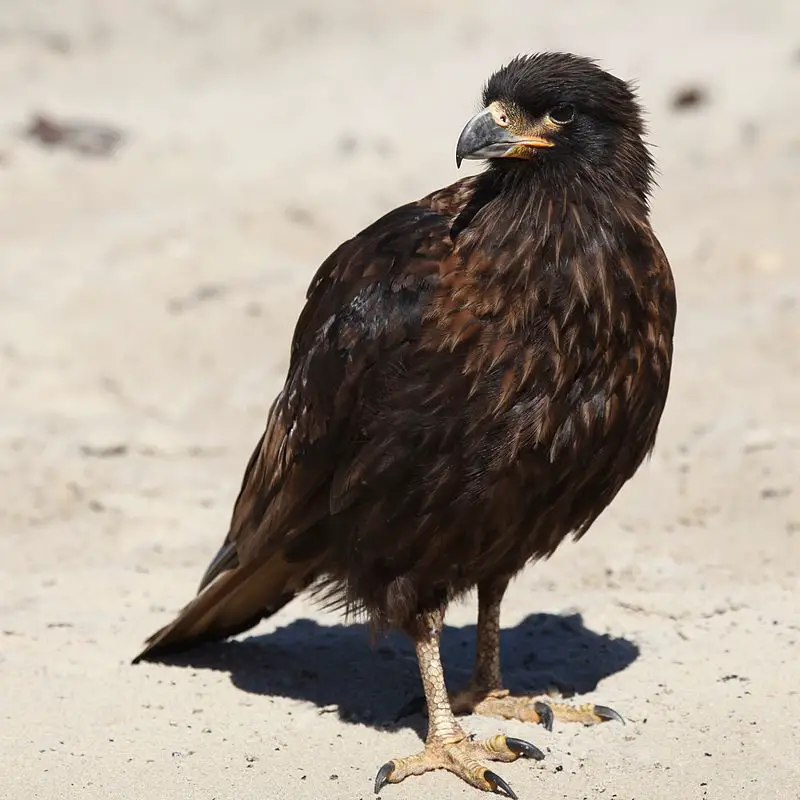
Known as the Johnny Rook in the Falkland Islands, the striated caracara is a bird of prey belonging to the falcon and caracara families. It is found in Argentina, Chile, and the Falkland Islands.
This bird is listed as Near Threatened and is also referred to as Forster’s caracara. It was first described in 1788 by the German scientist Johann Friedrich Gmelin.
As an apex predator, the striated caracara plays a crucial role in the ecosystem, controlling the population of small animals.
However, the population of striated caracaras is threatened due to habitat destruction and hunting.
Despite its name, the bird has a mottled appearance with black and white feathers. The striated caracara is a fascinating bird species essential to the ecosystem.
Scientific classification:
| Kingdom | Animalia |
| Phylum | Chordata |
| Class | Aves |
| Order | Falconiformes |
| Family | Falconidae |
| Genus | Phalcoboenus |
| Species | P. australis |
Also Featured In: Birds That Live around East Falkland, Native Birds Of West Falkland
13. Macaroni Penguin
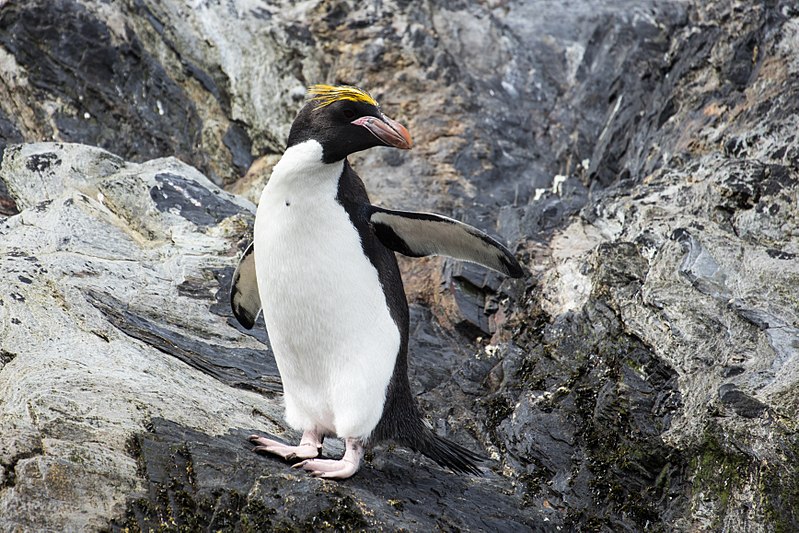
The Macaroni penguin is a type of crested penguin found in regions ranging from the Subarctic to the Antarctic Peninsula. Its striking appearance includes a black face and upperparts contrasting with the bird’s white underbelly.
The Macaroni penguin is easily recognized by its unique yellow crest. Some experts consider this bird and the royal penguin to be the same species due to their close relationship.
The Macaroni penguin is a fascinating species that is a master of swimming and diving in the frigid waters of the South Atlantic.
Scientific classification:
| Kingdom | Animalia |
| Phylum | Chordata |
| Class | Aves |
| Order | Sphenisciformes |
| Family | Spheniscidae |
| Genus | Eudyptes |
| Species | E. chrysolophus |
Also Featured In: Common Birds of Weddell Island,
14. White-Tufted Grebe
The White-tufted grebe, also known as Rolland’s grebe, is an aquatic bird species in the family Podicipedidae. It is native to the southern half of South America and can be found in freshwater lakes, ponds, and sluggish streams.
This bird is recognized by its distinctive white tuft of feathers on its head. Interestingly, the males and females of this species are identical in appearance and behavioural characteristics.
White-tufted grebes are known for their excellent diving abilities and can stay underwater for extended periods.
There are three recognized subspecies of this bird. Overall, the White-tufted grebe is a fascinating aquatic bird that is well-adapted to life in freshwater habitats.
Scientific classification:
| Kingdom | Animalia |
| Phylum | Chordata |
| Class | Aves |
| Order | Podicipediformes |
| Family | Podicipedidae |
| Genus | Rollandia |
| Species | R. rolland |
Conclusion
The Jason Islands, nestled within the Falkland Islands, harbour a remarkable array of avian species, many of which may not be widely known to the general public.
From the charming Cobb’s Wren and South Georgia Pipit to the striking Striated Caracara and elegant Black-browed Albatross, these islands boast a diverse and captivating birdlife.
These birds have adapted to the challenging South Atlantic environment with their unique adaptations.
The Jason Islands serve as an important haven for both resident and migratory species, showcasing the significance of protecting and conserving these remote ecosystems to ensure the continued survival of these lesser-known but incredibly fascinating avian inhabitants.